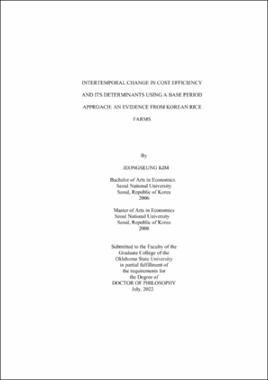| dc.contributor.advisor | Chung, Chanjin | |
| dc.contributor.author | Kim, Jeongseung | |
| dc.date.accessioned | 2023-04-05T16:20:57Z | |
| dc.date.available | 2023-04-05T16:20:57Z | |
| dc.date.issued | 2022-07 | |
| dc.identifier.uri | https://hdl.handle.net/11244/337288 | |
| dc.description.abstract | The objective of our study is to propose a procedure for intertemporal comparison of technical and cost efficiencies across years. The procedure measures the efficiency change while excluding the frontier shift effect using the base period approach. Our first contribution to the literature is to develop a procedure that can allow intertemporal comparison for cost efficiency (CE). The newly developed procedure first decomposes the change in the standard CE, estimated with a different frontier and input prices each year, into four factors: technology change, individual effort for technical efficiency (TE) change, price effect, and individual effort for allocative efficiency (AE) change. Then, the intertemporal change in CE, estimated with the base-period frontier, is calculated after eliminating technology change and price effect from the change in the standard CE. Our second contribution is to statistically test mean differences of efficiency scores using a sample T-test based on the asymptotic normal distribution, following Kneip, Simar, and Wilson. (2015, 2016), and Simar and Wilson (2020). The third contribution is to conduct a two-stage analysis using efficiency scores estimated from the based period approach. A few earlier studies also conduct a two-stage regression analysis to show effects of factors other than already considered to estimate efficiency scores. However, earlier studies use the standard efficiency scores estimated with changing frontiers each year, which makes difficult the scores comparable over time. We compare regression results estimated from our base period approach with those estimated with the standard approach. | |
| dc.description.abstract | Overall, our study finds that the two methods produced different results. Technical and cost efficiency in 2017 are less than 2008 and 2013 when the standard method with different base-frontier approach. However, when the base period approach is used, technical and cost efficiencies in 2017 improved from 2008 and 2013, while two efficiency scores from the conventional approach decreased in 2017 from 2008 and 2013. The two distinctively different results show that the conventional approach with different base-frontiers could result in erroneous policy implications. Regression results with estimated efficiency scores from standard and base period approach show no distinct difference except year dummies. | |
| dc.format | application/pdf | |
| dc.language | en_US | |
| dc.rights | Copyright is held by the author who has granted the Oklahoma State University Library the non-exclusive right to share this material in its institutional repository. Contact Digital Library Services at lib-dls@okstate.edu or 405-744-9161 for the permission policy on the use, reproduction or distribution of this material. | |
| dc.title | Intertemporal change in cost efficiency and its determinants using a base period approach: An evidence from Korean rice farms | |
| dc.contributor.committeeMember | Adam, Brian | |
| dc.contributor.committeeMember | Schatzer, Raymond | |
| dc.contributor.committeeMember | Kim, Jaebeom | |
| osu.filename | Kim_okstate_0664D_17793.pdf | |
| osu.accesstype | Open Access | |
| dc.type.genre | Dissertation | |
| dc.type.material | Text | |
| dc.subject.keywords | comparison | |
| dc.subject.keywords | determinant | |
| dc.subject.keywords | efficiency | |
| dc.subject.keywords | intertemporal | |
| thesis.degree.discipline | Agricultural Economics | |
| thesis.degree.grantor | Oklahoma State University | |
